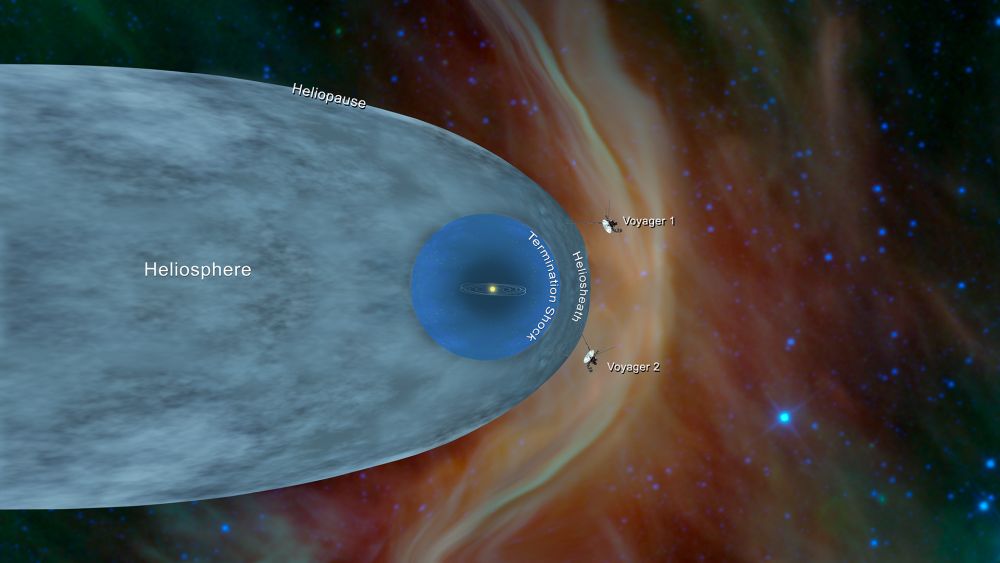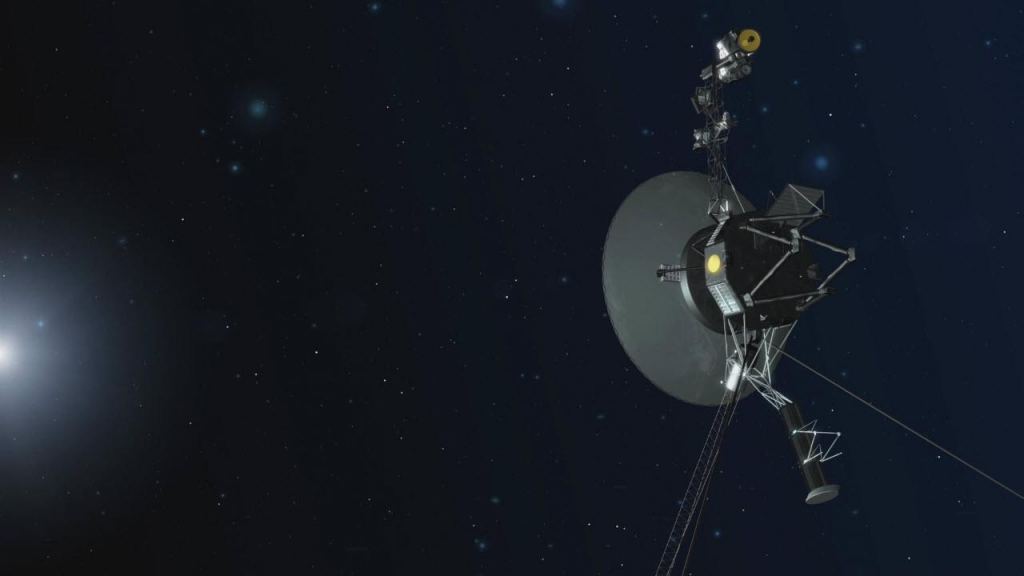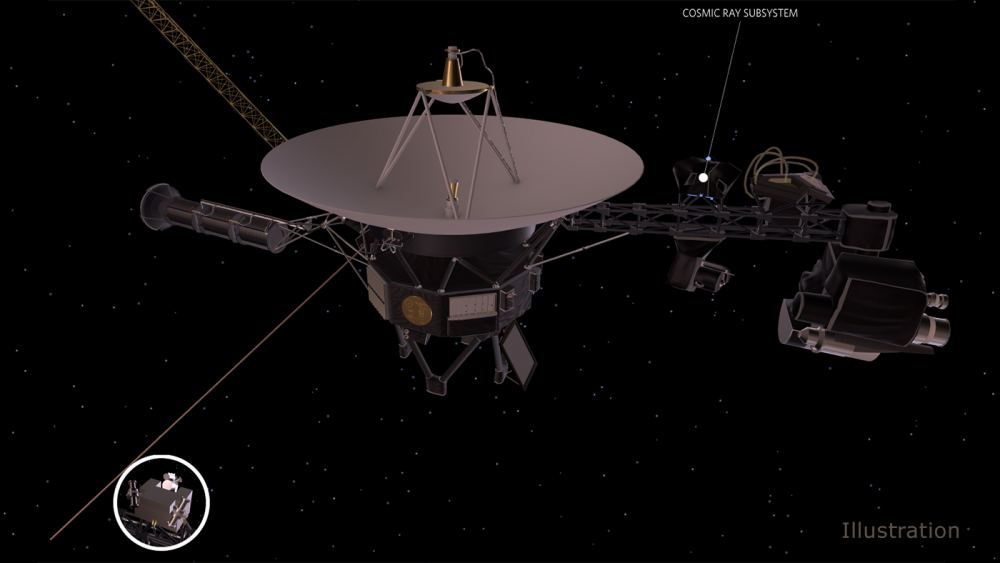Voyagers 1 and 2 have the distinction of being in space for 42 years and still operating. And even though they’re 18 billion km (11 billion miles) from the Sun, they’re still valuable scientifically. But they’re running out of energy, and if NASA wants them to continue on much longer, they have some decisions to make.
The Energy Problem
The energy issue is becoming more and more critical over time for the Voyagers. Not only do their scientific instruments require energy, but the spacecraft need to keep themselves warm in the frigid environment of space. The pair of spacecraft aren’t solar powered: that wouldn’t be possible so far from the Sun. They rely on radioisotope thermoelectric generators (RTG) for their energy.
Each of the Voyager probes has three RTGs, and they use plutonium 238 for their fuel source. As that isotope decays, it produces heat which is converted to electrical energy. Each Voyager launched generating 470 watts at 30 volts DC, but over time that degrades. Not only is the fuel steadily depleted, but the thermocouples used in the system degrade over time. As of 2011, both Voyagers were generating just under 270 watts, which is about 76% of the power they started out with.

While that 270 watts is better than predicted when the probes were designed and launched, it still means that inevitable decisions need to be made about which spacecraft systems need to be turned off.
First off, you’ve gotta give NASA credit for keeping the probes going this long. It’s amazing in its own right. Some parts of the probes have already had their power turned off, and remarkably, they’re still performing.
In response to energy concerns, in 2011 NASA turned off the heater for Voyager 1’s ultraviolet spectrometer. That instrument was designed to operate at temperatures as low as -35 degrees Celsius (-31 degrees Fahrenheit), but after its heater was turned off, it kept working at -79 degrees Celsius (-110 degrees Fahrenheit.)
“It’s incredible that Voyagers’ instruments have proved so hardy.”
Voyager Project Manager Suzanne Dodd
But that was in 2011, and since then the RTGs have lost even more power. In fact, they lose about .8% of their power output each year. Now, NASA engineers are sharpening their slide rules and putting a new energy management plan in place to keep the probes going even longer.
Turning The Heat Off To Keep The Voyagers Going
Recently, NASA decided to turn off the heater for another instrument, this time on Voyager 2. They’ve turned off the heat for Voyager 2’s Cosmic Ray Subsystem (CRS). That’s too bad, because back in November 2018, the CRS instrument was key in determining that Voyager 2 had left the heliosphere and entered interstellar space. Ever since the probes left the heliosphere, they’ve been sending us unique and important information about how the heliosphere interacts with the interstellar wind. No other spacecraft can do that, and to put another one in place would take decades.

But even though the instrument heater for Voyager 2’s Cosmic Ray Subsystem (CRS) has been turned off, engineers confirmed that the instrument is still working at -59 Celsius (-74 F), even though they were only tested down to -45 C (-49F.)
“It’s incredible that Voyagers’ instruments have proved so hardy,” said Voyager Project Manager Suzanne Dodd, who is based at NASA’s Jet Propulsion Laboratory in Pasadena, California. “We’re proud they’ve withstood the test of time. The long lifetimes of the spacecraft mean we’re dealing with scenarios we never thought we’d encounter. We will continue to explore every option we have in order to keep the Voyagers doing the best science possible.”
As it stands now, Voyager 2 is still returning data from five instruments, even though the CRS had its heat turned off. In particular, it’s still heating the Low-Energy Charged particle instrument. That’s because it can return data on the transition out of the heliosphere in much the same way that CRS can. The CRS is uni-directional, while the Low-Energy instrument is omni-directional, which is one of the reasons the CRS had its heat turned off.
Delaying the Inevitable
Generating heat is an energy intensive activity. As the power in the probes runs down, eventually more heaters will have to be turned off to allow the remaining instruments to operate. There’s no way around it. But the shrinking energy budget on the probes also affects other systems besides scientific instruments.
The probes have small thrusters and they are critical to the probes’ operation. The spacecraft have to be oriented so that their antennae face Earth for them to receive commands and return data to Earth. Each spacecraft has a tank of hydrazine monopropellant fuel used to power their small thrusters, which operate in tiny bursts or puffs to orient the spacecraft.

If the lines feeding the fuel to the thrusters froze, then engineers would be unable to aim the spacecrafts’ antennae or instruments. At that point, the spacecraft would likely be useless. So they require heat as well.
However, there’s another problem with the thrusters. Inevitably, systems like those break down over time, and in 2017 engineers noticed a problem. Some of the thrusters on Voyager 1 were having to work harder to maintain the correct orientation toward Earth. So they turned to some long-unused thrusters to see if they could get the job done.
Believe it or not, this secondary set of thrusters hadn’t been used for 37 years. But they were fired up and they did their job. That’s got to be some kind of record in itself.

Now, the main thrusters on Voyager 2 are starting to show problems. With the success they had with Voyager 1’s old, unused thrusters, engineers have decided to fire up the old backup thrusters on Voyager 2 as well. But these ones haven’t been dormant as long as Voyager 1’s were. They were last used when Voyager 1 encountered Neptune in 1989 30 years ago, and NASA plans to turn them on later this month.
With clever engineering, careful planning, and judicious use of both Voyagers’ remaining energy, the inevitable end for the spacecraft is being delayed. As a result, their ongoing scientific contributions can continue into the future for a while yet.
“Both Voyager probes are exploring regions never before visited, so every day is a day of discovery.”
Voyager Project Scientist Ed Stone
Engineers and mission planners think that there’s still a few years of operational capability left. That’s important, because everything we’re learning about the region of space they’re in is because of their unique position to observe it. That can’t be understated, because new papers are still being written based on Voyager data, not only from where they are now, but from where they were years, even decades, ago.
In 2017, NASA former chair of NASA’s Outer Planet Assessment Group Fran Bagenal was interviewed in Nautilus. In that interview she said, “I’m still analyzing Voyager data, believe it or not. We’ve just published three papers on Voyager data that was taken 33 years ago, at the same time that we’re all celebrating the 40th anniversary of the launch. It was fun. I realized that some of the data I had done my thesis on, from 1979, had not been reanalyzed.”
It begs the question, how many future papers based on current data might be written decades from now?
Nothing Lasts Forever
The Voyager program’s most famous photos is the Pale Blue Dot photo (actually a series of photos.) We no longer receive any photos from the Voyager cameras. There’s nothing to take pictures of way out there. But it’s almost uncanny how those spacecraft are still delivering data, unique data, so many decades after they were designed, built, and launched. In an odd way, they’re like time capsules of early space exploration technology.

“Both Voyager probes are exploring regions never before visited, so every day is a day of discovery,” said Voyager Project Scientist Ed Stone, who is based at Caltech. “Voyager is going to keep surprising us with new insights about deep space.”
Nothing lasts forever and one day that’ll be it for the Voyager spacecraft. For people knowledgeable about the missions, and who have an inkling of what they’ve contributed to humanity’s knowledge, that’ll be a sad day. It’s strange to think of all that’s gone on here on Earth while the two spacecraft have been making their journey.
The good news is that future spacecraft will build on the work done by the Voyager program.

NASA is launching the Interstellar Mapping and Acceleration Probe (IMAP) in 2024, and it will capitalize on the Voyagers’ observations. Their Interstellar Boundary Explorer (IBEX) is already building on the work of Voyager 1 and 2 and giving us more detailed info on the heliosphere.
In the same Nautilus interview, Fran Bagenal said, “I would predict that we’ll cease to be able to communicate with it somewhere around another 15 years time or so.” She’s not an official spokesperson for the Voyager program, but if she’s accurate, that means that communications may end by 2032.
Mark that date on your calendar.
Sources:
- Press Release: A New Plan for Keeping NASA’s Oldest Explorers Going
- NASA: Voyager Program
- Press Release: Voyager 1 Fires Up Thrusters After 37 Years
- Press Release: NASA’s Voyager 2 Probe Enters Interstellar Space
- Press Release: Voyager Instrument Cooling After Heater Turned off
- Universe Today: Finally! Voyager 2 is Now in Interstellar Space
- Wikipedia Entry: Voyager Program

